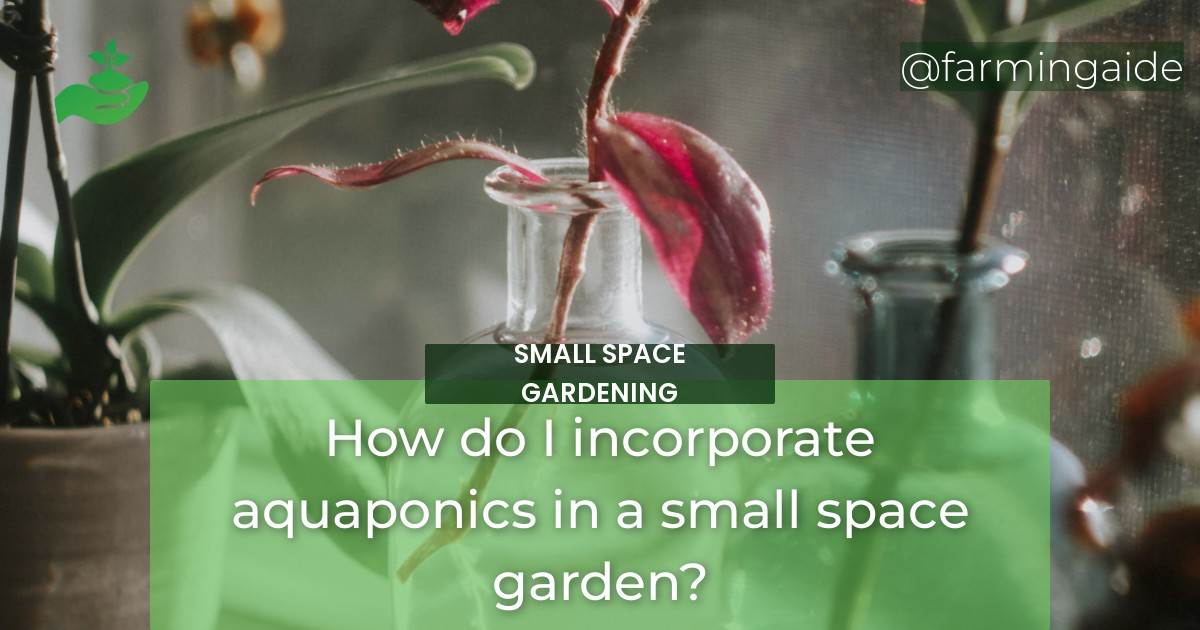Incorporating aquaponics in small space gardening is an innovative and sustainable way to grow plants and fish together. Aquaponics is the combination of aquaculture and hydroponics, where fish waste is used as fertilizer for plants, and plants, in turn, purify the water for the fish.
Understanding Aquaponics
Definition of Aquaponics
Aquaponics is a sustainable farming technique that combines the principles of aquaculture (raising fish) and hydroponics (growing plants without soil) to create a closed-loop ecosystem. The system relies on the symbiotic relationship between fish and plants, where fish waste is converted into nutrients for plants, and plants filter the water for the fish.
How Aquaponics Works
The system consists of a fish tank, a grow bed, and a water pump. The fish produce waste that is pumped up to the grow bed, where bacteria convert it into nitrates, which the plants use as food. The plants absorb the nutrients and filter the water, which is then pumped back into the fish tank.
Benefits of Aquaponics
- Aquaponics uses 90% less water than traditional farming techniques.
- It eliminates the need for chemical fertilizers and pesticides.
- Aquaponics can produce up to ten times more vegetables than traditional farming.
- The system is self-sustaining and requires minimal maintenance.
Choosing a Small Space for Aquaponics
Indoor vs Outdoor Aquaponics
Aquaponics can be set up both indoors and outdoors, depending on the available space and the type of plants and fish you want to grow. Indoor aquaponics is suitable for small spaces, while outdoor aquaponics requires more space and is suitable for larger gardens or backyards.
Evaluating Space for Aquaponics
When evaluating a space for aquaponics, consider the following factors:
- Access to natural light
- Temperature control
- Water source and quality
- Electricity supply
Factors to Consider in Choosing a Location
When choosing a location for your aquaponics system, consider the following factors:
- The weight-bearing capacity of the floor or surface
- The proximity to a power source and water supply
- The level of noise and vibration the system will produce
- The ease of access for maintenance and harvesting
ALSO READ
Setting up Aquaponics in Small Spaces
Choosing an Aquaponics System
There are various types of aquaponics systems available, including:
- Media-based systems
- Nutrient film technique (NFT) systems
- Deep water culture (DWC) systems
For small spaces, a media-based system is the most suitable option. It uses a growing medium such as gravel or clay pebbles to support the plants and provides a stable environment for the bacteria to grow.
Setting up the Aquaponics System
The following steps are involved in setting up an aquaponics system:
- Set up the fish tank and fill it with water.
- Install a water pump to circulate the water between the fish tank and the grow bed.
- Place the grow bed above the fish tank and fill it with a growing medium.
- Add fish to the tank and test the water quality.
- Introduce plants to the grow bed and monitor their growth.
Adding Fish and Plants
When choosing fish for your aquaponics system, consider the following factors:
- The size of the fish tank
- The water temperature
- The pH level of the water
- The type of fish you want to grow
When choosing plants for your aquaponics system, consider the following factors:
- The type of plants you want to grow
- The nutrient requirements of the plants
- The pH level of the water
- The amount of light the plants need
Caring for Aquaponics in Small Spaces
Monitoring Water Quality
It is essential to monitor the water quality in your aquaponics system regularly. Test the pH level, ammonia, nitrite, and nitrate levels weekly to ensure that the system is balanced.
Feeding Fish and Plants
Feed the fish small amounts of food multiple times a day to ensure that they are getting the right amount of nutrients. As for the plants, ensure that they are getting the right amount of light, water, and nutrients.
Pruning and Harvesting Plants
Prune the plants regularly to keep them healthy and promote growth. Harvest the plants when they are mature and ready to eat.
ALSO READ
Tips for Successful Aquaponics in Small Spaces
Choosing the Right Fish and Plants
Choose fish and plants that are suitable for your space and environment. Consider the water temperature, pH level, and nutrient requirements of the fish and plants.
Managing Light and Temperature
Ensure that your aquaponics system gets enough natural light or use grow lights to provide artificial light. Maintain the water temperature within the optimal range for the fish and plants.
Troubleshooting Common Problems
Common problems in aquaponics systems include algae growth, pH fluctuations, and disease outbreaks. Regular monitoring and maintenance can prevent or solve these problems.
Benefits of Aquaponics in Small Space Gardening
Space-Saving Solution
Aquaponics is a space-saving solution for small space gardening. It allows you to grow plants and fish together in a closed-loop system, without the need for soil or chemical fertilizers.
Sustainable and Organic Gardening
Aquaponics is a sustainable and organic gardening technique that promotes healthy and natural growth of plants and fish.
Health Benefits of Eating Homegrown Produce
Eating homegrown produce from aquaponics systems is nutritious and free from harmful chemicals and pesticides. It promotes a healthy lifestyle and reduces the environmental impact of commercial farming.
Conclusion
Summary of Benefits and Tips
Incorporating aquaponics in small space gardening is a sustainable and innovative way to grow plants and fish together. The system requires minimal maintenance and produces fresh and healthy produce.
Encouragement to Try Aquaponics in Small Spaces
With the right knowledge and tools, anyone can set up an aquaponics system in small spaces and enjoy the benefits of sustainable and organic gardening.


